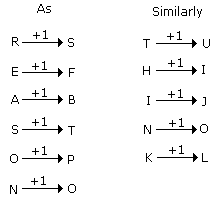Air Force Group Y Mock Test - 10 - Airforce X Y / Indian Navy SSR MCQ
30 Questions MCQ Test - Air Force Group Y Mock Test - 10
He persisted / to do it / in spite of my advice / No error.
In the following questions four alternatives are given for the idiom/phrase italicised and underlined in the sentence. Choose the alternative which best expresses the meaning of idiom/phrase.
Q. I did not mind what he was saying, he was only through his hat.
Today most businessmen are very worried. To begin with, they are not used to competition.In the past they sold whatever ...(1)... produced at whatever prices they chose. But ...(2)... increasing competition, customers began to ...(3)... and choose. Imports suddenly became ...(4)... available and that too at cheaper ...(5)...
What will come in Option Four?
Today most businessmen are very worried. To begin with, they are not used to competition.In the past they sold whatever ...(1)... produced at whatever prices they chose. But ...(2)... increasing competition, customers began to ...(3)... and choose. Imports suddenly became ...(4)... available and that too at cheaper ...(5)...
What will come in Option Five?
Which of the following is the FIRST sentence after rearrangement?
Directions: Four statements are given below. Among these, three statements are in logical order and form a coherent paragraph/passage. From the given options, choose the option that does not fit into the theme of the passage.
Direction: In each of the questions given below, a sentence is given with two blanks. From the given options, choose the one that gives the correct combination of words that fit in the blanks.
In a _______________ to the exchanges, the company said it intends to _______________ the date of submission of the Q1 results.
Direction: In each of the questions given below, a sentence is given with two blanks. From the given options, choose the one that gives the correct combination of words that fit in the blanks.
RTO officials have taken _______________ of the video and plan a massive drive from this week to _______________ out the rogues.
Direction: Read the following passage carefully and answer the question that follows.
After a worrying pre-monsoon phase between March and May, when rainfall was scarce, the current robust season in most parts of coastal, western and central India augurs well for the entire economy. Aided apparently by beneficial conditions in the Indian Ocean, very heavy rainfall has been recorded, notably in Maharashtra, Gujarat, Rajasthan, the northeastern States, Karnataka, the Konkan coast, hilly districts of Kerala and Tamil Nadu. This pattern may extend into Chhattisgarh, Odisha, Bengal and other eastern regions. A normal Indian Summer Monsoon is bountiful overall, but as last year’s flooding in Kerala, and the Chennai catastrophe of 2015 showed, there can be a terrible cost in terms of lives and property lost, and people displaced. Distressing scenes of death and destruction are again being witnessed. Even in a rain-shadow region such as Coimbatore in Tamil Nadu, the collapse of a railway parcel office after a downpour has led to avoidable deaths. What this underscores is the need to prepare for the rainy season with harvesting measures, as advocated by the Centre’s Jal Shakti Abhiyan, and a safety audit of structures, particularly those used by the official agencies. In drafting their management plans, States must be aware of the scientific consensus: that future rain spells may be short, often unpredictable and very heavy influenced by a changing climate. They need to invest in reliable infrastructure to mitigate the impact of flooding and avert disasters that could have global consequences in an integrated economy.
The long-term trends for flood impact in India have been one of declining loss of lives and cattle since the decadal high of 1971-80, but rising absolute economic losses, though not as a share of GDP. It is important, therefore, to increase resilience through planning, especially in cities and towns which are expanding steadily. Orderly urban development is critical for sustainability, as the mega flood disasters in Mumbai and Chennai witnessed in this century make clear. It is worth pointing out that the response of State governments to the imperative is tardy and even indifferent. They are hesitant to act against encroachment of lake catchments, river courses and floodplains. The extreme distress in Chennai, for instance, has not persuaded the State government against allowing structures such as a police station being constructed on a lake bed, after reclassification of land. Granting such permissions is an abdication of responsibility and a violation of National Disaster Management Authority Guidelines to prevent urban flooding. As a nation that is set to become the most populous in less than a decade, India must address its crippling cycles of drought and flood with redoubled vigour. Scientific hydrology, coupled with the traditional wisdom of saving water through large innovative structures, will mitigate floods and help communities prosper.
Q. Which among the following is/are correct according to the information given in the passage?
I. The National Disaster Management Authority Guidelines prevent the government to give permission to construct something by changing the nature of the land.
II. Chennai administration is not at all interested in taking preventive measures to control flood in the city.
III. There have been too many encroachments in the river bed areas in various cities across the country.
Direction: Read the following passage carefully and answer the question that follows.
After a worrying pre-monsoon phase between March and May, when rainfall was scarce, the current robust season in most parts of coastal, western and central India augurs well for the entire economy. Aided apparently by beneficial conditions in the Indian Ocean, very heavy rainfall has been recorded, notably in Maharashtra, Gujarat, Rajasthan, the northeastern States, Karnataka, the Konkan coast, hilly districts of Kerala and Tamil Nadu. This pattern may extend into Chhattisgarh, Odisha, Bengal and other eastern regions. A normal Indian Summer Monsoon is bountiful overall, but as last year’s flooding in Kerala, and the Chennai catastrophe of 2015 showed, there can be a terrible cost in terms of lives and property lost, and people displaced. Distressing scenes of death and destruction are again being witnessed. Even in a rain-shadow region such as Coimbatore in Tamil Nadu, the collapse of a railway parcel office after a downpour has led to avoidable deaths. What this underscores is the need to prepare for the rainy season with harvesting measures, as advocated by the Centre’s Jal Shakti Abhiyan, and a safety audit of structures, particularly those used by the official agencies. In drafting their management plans, States must be aware of the scientific consensus: that future rain spells may be short, often unpredictable and very heavy influenced by a changing climate. They need to invest in reliable infrastructure to mitigate the impact of flooding and avert disasters that could have global consequences in an integrated economy.
The long-term trends for flood impact in India have been one of declining loss of lives and cattle since the decadal high of 1971-80, but rising absolute economic losses, though not as a share of GDP. It is important, therefore, to increase resilience through planning, especially in cities and towns which are expanding steadily. Orderly urban development is critical for sustainability, as the mega flood disasters in Mumbai and Chennai witnessed in this century make clear. It is worth pointing out that the response of State governments to the imperative is tardy and even indifferent. They are hesitant to act against encroachment of lake catchments, river courses and floodplains. The extreme distress in Chennai, for instance, has not persuaded the State government against allowing structures such as a police station being constructed on a lake bed, after reclassification of land. Granting such permissions is an abdication of responsibility and a violation of National Disaster Management Authority Guidelines to prevent urban flooding. As a nation that is set to become the most populous in less than a decade, India must address its crippling cycles of drought and flood with redoubled vigour. Scientific hydrology, coupled with the traditional wisdom of saving water through large innovative structures, will mitigate floods and help communities prosper.
Q. Which among the following gives us the correct picture of monsoon in the current year as stated in the passage?
Direction: Read the following passage carefully and answer the question that follows.
After a worrying pre-monsoon phase between March and May, when rainfall was scarce, the current robust season in most parts of coastal, western and central India augurs well for the entire economy. Aided apparently by beneficial conditions in the Indian Ocean, very heavy rainfall has been recorded, notably in Maharashtra, Gujarat, Rajasthan, the northeastern States, Karnataka, the Konkan coast, hilly districts of Kerala and Tamil Nadu. This pattern may extend into Chhattisgarh, Odisha, Bengal and other eastern regions. A normal Indian Summer Monsoon is bountiful overall, but as last year’s flooding in Kerala, and the Chennai catastrophe of 2015 showed, there can be a terrible cost in terms of lives and property lost, and people displaced. Distressing scenes of death and destruction are again being witnessed. Even in a rain-shadow region such as Coimbatore in Tamil Nadu, the collapse of a railway parcel office after a downpour has led to avoidable deaths. What this underscores is the need to prepare for the rainy season with harvesting measures, as advocated by the Centre’s Jal Shakti Abhiyan, and a safety audit of structures, particularly those used by the official agencies. In drafting their management plans, States must be aware of the scientific consensus: that future rain spells may be short, often unpredictable and very heavy influenced by a changing climate. They need to invest in reliable infrastructure to mitigate the impact of flooding and avert disasters that could have global consequences in an integrated economy.
The long-term trends for flood impact in India have been one of declining loss of lives and cattle since the decadal high of 1971-80, but rising absolute economic losses, though not as a share of GDP. It is important, therefore, to increase resilience through planning, especially in cities and towns which are expanding steadily. Orderly urban development is critical for sustainability, as the mega flood disasters in Mumbai and Chennai witnessed in this century make clear. It is worth pointing out that the response of State governments to the imperative is tardy and even indifferent. They are hesitant to act against encroachment of lake catchments, river courses and floodplains. The extreme distress in Chennai, for instance, has not persuaded the State government against allowing structures such as a police station being constructed on a lake bed, after reclassification of land. Granting such permissions is an abdication of responsibility and a violation of National Disaster Management Authority Guidelines to prevent urban flooding. As a nation that is set to become the most populous in less than a decade, India must address its crippling cycles of drought and flood with redoubled vigour. Scientific hydrology, coupled with the traditional wisdom of saving water through large innovative structures, will mitigate floods and help communities prosper.
Q. Which among the following is correct regarding the pattern of rainfall in the future as declared by the scientific community?
Direction: Read the following passage carefully and answer the question that follows.
After a worrying pre-monsoon phase between March and May, when rainfall was scarce, the current robust season in most parts of coastal, western and central India augurs well for the entire economy. Aided apparently by beneficial conditions in the Indian Ocean, very heavy rainfall has been recorded, notably in Maharashtra, Gujarat, Rajasthan, the northeastern States, Karnataka, the Konkan coast, hilly districts of Kerala and Tamil Nadu. This pattern may extend into Chhattisgarh, Odisha, Bengal and other eastern regions. A normal Indian Summer Monsoon is bountiful overall, but as last year’s flooding in Kerala, and the Chennai catastrophe of 2015 showed, there can be a terrible cost in terms of lives and property lost, and people displaced. Distressing scenes of death and destruction are again being witnessed. Even in a rain-shadow region such as Coimbatore in Tamil Nadu, the collapse of a railway parcel office after a downpour has led to avoidable deaths. What this underscores is the need to prepare for the rainy season with harvesting measures, as advocated by the Centre’s Jal Shakti Abhiyan, and a safety audit of structures, particularly those used by the official agencies. In drafting their management plans, States must be aware of the scientific consensus: that future rain spells may be short, often unpredictable and very heavy influenced by a changing climate. They need to invest in reliable infrastructure to mitigate the impact of flooding and avert disasters that could have global consequences in an integrated economy.
The long-term trends for flood impact in India have been one of declining loss of lives and cattle since the decadal high of 1971-80, but rising absolute economic losses, though not as a share of GDP. It is important, therefore, to increase resilience through planning, especially in cities and towns which are expanding steadily. Orderly urban development is critical for sustainability, as the mega flood disasters in Mumbai and Chennai witnessed in this century make clear. It is worth pointing out that the response of State governments to the imperative is tardy and even indifferent. They are hesitant to act against encroachment of lake catchments, river courses and floodplains. The extreme distress in Chennai, for instance, has not persuaded the State government against allowing structures such as a police station being constructed on a lake bed, after reclassification of land. Granting such permissions is an abdication of responsibility and a violation of National Disaster Management Authority Guidelines to prevent urban flooding. As a nation that is set to become the most populous in less than a decade, India must address its crippling cycles of drought and flood with redoubled vigour. Scientific hydrology, coupled with the traditional wisdom of saving water through large innovative structures, will mitigate floods and help communities prosper.
Q. Which among the following is correct regarding the response of the states to the need to tackle flood situations?
Direction: Read the following passage carefully and answer the question that follows.
After a worrying pre-monsoon phase between March and May, when rainfall was scarce, the current robust season in most parts of coastal, western and central India augurs well for the entire economy. Aided apparently by beneficial conditions in the Indian Ocean, very heavy rainfall has been recorded, notably in Maharashtra, Gujarat, Rajasthan, the northeastern States, Karnataka, the Konkan coast, hilly districts of Kerala and Tamil Nadu. This pattern may extend into Chhattisgarh, Odisha, Bengal and other eastern regions. A normal Indian Summer Monsoon is bountiful overall, but as last year’s flooding in Kerala, and the Chennai catastrophe of 2015 showed, there can be a terrible cost in terms of lives and property lost, and people displaced. Distressing scenes of death and destruction are again being witnessed. Even in a rain-shadow region such as Coimbatore in Tamil Nadu, the collapse of a railway parcel office after a downpour has led to avoidable deaths. What this underscores is the need to prepare for the rainy season with harvesting measures, as advocated by the Centre’s Jal Shakti Abhiyan, and a safety audit of structures, particularly those used by the official agencies. In drafting their management plans, States must be aware of the scientific consensus: that future rain spells may be short, often unpredictable and very heavy influenced by a changing climate. They need to invest in reliable infrastructure to mitigate the impact of flooding and avert disasters that could have global consequences in an integrated economy.
The long-term trends for flood impact in India have been one of declining loss of lives and cattle since the decadal high of 1971-80, but rising absolute economic losses, though not as a share of GDP. It is important, therefore, to increase resilience through planning, especially in cities and towns which are expanding steadily. Orderly urban development is critical for sustainability, as the mega flood disasters in Mumbai and Chennai witnessed in this century make clear. It is worth pointing out that the response of State governments to the imperative is tardy and even indifferent. They are hesitant to act against encroachment of lake catchments, river courses and floodplains. The extreme distress in Chennai, for instance, has not persuaded the State government against allowing structures such as a police station being constructed on a lake bed, after reclassification of land. Granting such permissions is an abdication of responsibility and a violation of National Disaster Management Authority Guidelines to prevent urban flooding. As a nation that is set to become the most populous in less than a decade, India must address its crippling cycles of drought and flood with redoubled vigour. Scientific hydrology, coupled with the traditional wisdom of saving water through large innovative structures, will mitigate floods and help communities prosper.
Q. Which among the following is correct regarding the impact of flood in India over the years starting from 1970s?
Directions: Out of the given alternatives, choose the one which can be substituted for the given words/sentence.
Custom of having many wives:
The opinions and the comments about the working of the government are also expressed through media like
Hemant walked 40 metres facing towards North. From there he walked 50 metres after turning to his left. After this he walked 40 metres after turning to his left. How far and in what direction is he now from his starting point?
Directions to Solve
In each of the following questions, five words have been given out of which four are alike in some manner, while the fifth one is different. Choose the word which is different from the rest.
Question -
Choose the word which is different from the rest.
Directions to Solve
In each of the following questions find out the alternative which will replace the question mark.
Question -
REASON : SFBTPO :: THINK : ?
Directions to Solve
In each of the following questions two statements are given. Which are followed by four conclusions (1), (2), (3) and (4). Choose the conclusions which logically follow from the given statements.
Question -
Statements: No door is dog. All the dogs are cats.
Conclusions:
- No door is cat.
- No cat is door.
- Some cats are dogs.
- All the cats are dogs.
Directions to Solve
In each of the following questions two statements are given. Which are followed by four conclusions (1), (2), (3) and (4). Choose the conclusions which logically follow from the given statements.
Question -
Statements: All green are blue. All blue are white.
Conclusions:
- Some blue are green.
- Some white are green.
- Some green are not white.
- All white are blue.
If A + B means A is the father of B; A - B means A is the brother B; A % B means A is the wife of B and A x B means A is the mother of B, which of the following shows that M is the maternal grandmother of T?
Find the one which does not belong to that group ?
From which state will Bangladesh start receiving electricity from a power plant in March?
Which company has signed a contract with the Government e-Marketplace (GeM) for developing, implementing, operating, and maintaining the GeM portal?
If in a certain code, BAT = 23 and CAT = 24, then how will you code BALL?
If each letter is coded by its position from the end of the English alphabet (i.e., Z = 1, Y = 2, …, A = 26).
Given A = 26 and SUN = 27, then CAT = ?
Directions: Study the following information carefully and answer the question given below.
Eight people O, H, U, V, I, D, B and G are sitting around a circular table facing the centre.
O is sitting second to the left of U and third to right of H. D and I are immediate neighbors of each other and one of them is an immediate neighbor of O. V is sitting second to the right of B. G is sitting second to the left of D.
Q. Which of the following pairs has only one person sitting between them, if the counting is done from the right of latter?





















